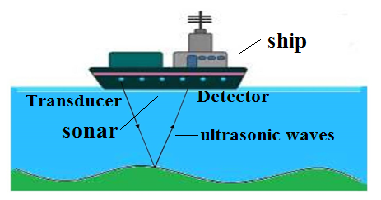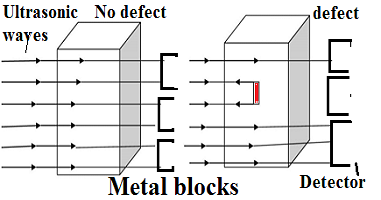NCERT solutions of class 9 science chapter 12-Sound
NCERT Solutions for Class 9 Chapter 12-Sound is the most ideal approach to upgrade one’s scientific concept on the chapter 12-sound. It contains answers to all unsolved questions that are given in the NCERT textbook so that the students could manage their study without any problem. NCERT Solutions is a reference manual for the preparation of worksheets and forthcoming board exams.
These NCERT Solutions contains a variety of questions and answers a few long, short answers alongside MCQs and important questions replied by the subject specialists. Each conceivable endeavor is made to make a great quality substance with all the helpful data. The Chapter Sound is vital from the assessment viewpoint.
The students are encouraged to go through the NCERT Solutions Class 9 for self-assessment in the wake of having concentrated every part. They will along these lines become more acquainted with their weaknesses and give a valiant effort to overcome the problems in chapter 12 before the assessments.
Click for online shopping
Future Study Point.Deal: Cloths, Laptops, Computers, Mobiles, Shoes etc
NCERT solutions of class 9 science chapter 12-Sound
You can also download PDF-NCERT solutions of class 9 science chapter 12-Sound
PDF-NCERT solutions of class 9 science chapter 12-Sound
Page no-162
Q1.How does the sound produced by a vibrating object in a medium reaches your ear.
Ans.When sound is produced by a vibrating object , it forces particles available near about it to vibrate,these particles compels other adjacent particles to vibrate, as a result of such subsequent processes sound transfered to in our ear through the vibration of these particles.
Page 163
Q1.Explain how sound is produced by your school bell.
Ans.When the bell is struck by the hammer, the particles of the matter by which the bell is made start to vibrate more than the frequency of 20 Hz which is a threshold of the audible frequency range.
Q2.Why are sound waves called mechanical waves?
Ans. Sound waves are called mechanical waves because when the sound produced by a source, this sound forces nearby particles to vibrate, these particles forces other particles to vibrate in the atmosphere, this is the way how sound propagates in the waveform.
Q3.Suppose you and your friend are on the moon. Will you be able to hear any sound produced by your friend?
Ans. We can not hear any sound in the moon because there is no atmosphere while sound propagates through the vibration of the atmospheric particles. So, I shall not be able to listen to the sound produced by my friend.
Page 166
Q1.Which wave property determines (a) Loudness (b) Pitch
Ans. (a)The amplitude of the sound wave determines the Loudness, if the amplitude of the sound is larger its loudness will also be increased.
(b)The frequency of sound is proportional to the pitch, the frequency of sound is more its pitch will also increase.
Q2.Guess which sound has a higher pitch, guitar or car horn.
Ans. The frequency of the sound produced by the guitar is more than the frequency of the sound produced by the car horn, frequency is more then the pitch will be more so the sound of the guitar will have more pitch.
Q3.What are the wavelength, frequency, time period, and amplitude of a sound wave?
Ans. Wavelength-The distance between two consecutive compressions or two consecutive rarefactions is known as wavelength. Its S.I unit is meter.
Frequency- The number of oscillations per second is known as the frequency of the sound waves. Its S.I unit is hertz.
Amplitude- The maximum height reached by the crest and trough of a sound wave is known as the amplitude of sound waves.
Q4.How are the wavelength and frequency of a sound wave related to its speed?
Ans. The relationship among, Wavelength- λ, Frequency- ν and speed- v is given as follows
The speed of the sound is the product of the frequency and wavelength of the sound waves.
v =νλ
Q5.Calculate the wavelength of a sound wave whose frequency is 220 Hz and speed is 440 m/s in a given medium.
Ans.Wavelength of a sound wave λ = ?, frequency ν = 220 Hz and speed V =440m/s
V = νλ
440 = 220 × λ
λ = 440/220
λ = 2
Therefore the wavelength of the sound wave is 2m
Q6.A person is listening to a tone of 500 Hz sitting at a distance of 450 m from the source of the sound. What is the time interval between successive compressions from the source?
Ans. As we know the time interval between two successive compressions is equal to the inverse of the frequency
Frequency of sound wave is given , = 500 hertz
Therefore the time interval between successive compressions of sound wave is 0.002 seconds
Q7.Distinguish between loudness and intensity of sound.
Ans. The loudness of sound is defined by its amplitude if the amplitude of the sound wave is more its loudness will be more. The intensity of sound is the amount of sound energy per unit area, it is determined by the amplitude of the sound. If the amplitude of the sound is more then the intensity of the sound will also be more.
Page no 167
Q1.In which of the three media, air, water, or iron, does sound travel the fastest at a particular temperature?
Ans. Sound travels faster in the denser medium so sound will move fastest in iron than water and least in air at constant temperature.
Page no 168
Q1.An echo returned in 3 s. What is the distance of the reflecting surface from the source. Given that the speed of sound is 342 ms-1?
Ans.Let the distance between the source of sound and reflecting surface is = x
Total distance covered by the signal of sound wave = 2x
Time is taken in covering the total distance = 3 s
Speed of sound = 342 m/s
Distance = speed × time
2x = 342 × 3
x = 513
Therefore the distance of reflecting surface from the source = 513 m
Page 169
Q1. Why are the ceiling of the concert hall is curved?
Ans. The ceiling of the concert hall is curved or concave, it is shaped like that because it reflects incoming sound waves from the source uniformly throughout the hall.
Page no 170
Q1.What is the audible range of the average human ear?
Ans. The audible range of the average human ear is 20 Hz to 20 KHz, where 1kHz = 10,000 Hz.
Q2.What is the range of frequencies associated with
(a) Infrasound?
(b)Ultrasound?
Ans.(a) Infrasound- The sound waves less than the frequency of 20 Hz, is known as infrasound.
(b)Ultrasound- The sound waves more than the frequency of 20 KHz.
Page no 172
Q1.A submarine emits a sonar pulse, which returns from an underwater cliff in 1.02 s. If the speed of sound in saltwater is 1531 m/s. How far away is the cliff?
Ans. Let the distance of the underwater cliff from the submarine = x
So the distance traveled by the sonar pulse = 2x
Time taken in traveling the distance = 1.02 s
Speed of sound in saltwater is = 1531m/s
distance = speed x time
2x = 1531 × 1.02
x = 1561.62/2
x = 780.31
Therefore the cliff is far away by 780.31 m from the submarine
EXERCISES
Q1.What is sound and how is it produced?
Ans. Sound is a type of energy. Sound is produced by the vibration of any object, this vibration forces the neighbouring particles available in the atmosphere to vibrate and these particles further forces adjacent particles to vibrate, in this way dense mediums and rare mediums are formed in the medium which is called compressions and rarefaction respectively.These disturbances when reaches to the diaphragm of the ear it also vibrates and sound is heard to us.
Q2. Describe with the help of a diagram, How compressions and rarefactions are produced in air near the source of the sound.
Ans.
The vibrations from the source of the sound force to displace the particles in air near to it and these particles displaces other particles near to them, this is the way how dense and rare mediums are formed in the air.
Q3.Cite an experiment to show that sound needs a material medium for its propagation.
Ans.Taking an electric bell and installing it inside an empty bell jar fitted with a vacuum pump as shown in the following figure.
After we on the switch Initially we hear the sound, now pump out the air inside the bell jar through the vacuum pump, as the amount of air decreases inside the jar the sound of the bell also decreases, and when finally the air inside it becomes absent or it is totally vacuumed the sound of the bell is not heard even we observe the prong of the bell still continued in vibration.This experiment shows that sound is a needed medium for its propagation.
Q4.Why is a sound wave called a longitudinal wave?
Ans.The sound generated by a source forces nearby particles to vibrate in the direction of the sound, so the sound waves and the direction of particles of the medium are the same. It is that is why sound waves are longitudinal waves.
Q5.Which characterstic of the sound helps you to identify your friend by his voice while sitting with others in a dark room ?
Ans.Loudness and pitch of the sound may be same of different sounds, It is only quality of sound through which we become able to distinguish different kinds of sounds. Therefore quality of sound helps us in identifying the sound of friend while sitting in a dark room.
Q6.Flash and thunder are produced simultaneously. But thunder is heard a few seconds after the flash is seen.Why ?
Ans. Speed of sound is 344 m/s and speed of light is 3 x 108m/s, which is much more than the speed of the sound, as we know the time = distance/speed, so the speed is more the time will be taken less. It is that’s why flash and thunder are produced simultaneously. But thunder is heard a few seconds after the flash is seen.
Q7.A person has a hearing range from 20 Hz to 20 KHz. What are the typical wavelength of sound waves in air corresponding to these two frequencies ? Take the speed of sound in air as 344 m/s.
Ans. We know the relationship between speed, frequency and wavelength
Let the wavelength of sound of frequency 20 Hz = λ1
Let the wavelength of sound of frequency 20 kHz =20000 Hz= λ2
Q8.Two children are at opposite ends of an aluminium rod. One strikes the end of the rod with a stone. Find the ratio of times taken by the sound wave in air and in aluminium to reach the second child .
Ans.Let the time taken in air = tair and time taken through aluminium rod =tal
Speed of sound wave in air = 346 m/s, and in aluminium = 6420 m/s
Let the length of rod = x
Time = Distance/Speed
tair = x/346, tal = x/6420
tair : tal = 346/6420 = almost it is 1 :19
Therefore the ratio of times taken by the sound wave in air and in aluminium to reach the second child is 1 :19
Q9.The frequency of a source of sound is 100 Hz. How many times does it vibrate in a minute?
Ans. Frequency is known as vibration per second,so
In 1 s vibration are = 100 ( frequency = 100 Hz)
So , in 60 s = 100 × 60 = 6000 vibrations (1 min = 60s)
Q10.Does sound follow the same laws of reflection as light does ? Explain.
Ans. In the case of sound waves
Incident angle = reflected angle
The incident wave reflected wave and normal to incident all lie in the same plane.
Hence sound waves follow rules of reflection of light.
Q11.When a sound is reflected from a distant object . an echo is produced . Let the distance between the reflecting surface and the source of sound production remains the same. Do you hear echo sound on a hotter day ?
Ans. The time interval between reflected sound and original sound if at least 0.1 s then an echo is heard to us.The speed of sound increases as the temperature increases . If the distance between source of sound and reflected sound remains the same, then during a hot day the time interval between original sound and reflected sound will decrease .
Q12. Give two practical applications of reflections of sound waves.
Ans.
(i) Reflection of sound waves is used to measure the depth of sea through SONAR.
(ii) Reflection of sound waves is used to measure heart rate through a stethoscope.
Q13.A stone is dropped from a tower 500 m high into a pond of water at the base of the tower. When is splash heard at the top? Given g= 10 m/s2 and speed of sound = 344 m/s.
Ans.Height of a tower = h= 500m
Acceleration =g= 10m/s2
Time taken by the stone to reach the ground = t1
Time taken by the sound to reach top of the tower =t2
Initial velocity of the stone = u =0
Speed of sound = 344 m/s
According to second equation of motion
h = ut + 1/2 (gt2)
500 = 0 x t1 + 1/2 (10 x t12)
5t12 =500
t1 = 10 s
t2 = height of tower/speed of sound
t2 = 500/344 = 1.44 s
Hence time taken by the splash produced by the stone
=t1 + t2=10 + 1.44 = 11.44 s
Q14.A sound wave travels at a speed of 339 m/s. If its wavelength is 1.5 cm, what is the frequency of wave ? Will it be audible ?
Ans.Speed of sound wave = v = 339 m/s
Wavelength of sound wave = λ =1.5 cm = 1.5/100 =0.015 m
Frequency of sound wave = f
v = f λ
f = v/λ
f = 339/0.015 = 22600 Hz
It will be non audible because audible range of sound is 20 Hz- 20000 Hz and the frequency of this wave is more than 20000 Hz.
Q15. What is reverberation ? How can it be reduced ?
Ans. In a large hall when sound is produced , it travels in all direction, it is reflected back from the wall, again this reflected sound reflected by other wall ,due to this sound can be heard even after the sorce has ceased to produce sound.This persistence of sound is known as reverberation .Due to this phenomena the listener could not hear the sound clearly.
To reduce the reverberation the ceiling of the hall must be of curved shape and made of sound absorbing material. The source of sound must be installed at the focal point of concave wall attached to it.The use of heavy curtains, fibre board and cushioned seats reduces the reverberation.
Q16.What is loudness ? What factor does it depend on ?
Ans. High energy of sound wave results loudness of sound. Loudness is proportional to the square of the amplitude of sound wave vibrations.
Q17.Explain how bats use ultrasound to catch a prey.
Ans. Bats produces ultrasonic waves , these waves travels in all directions and reflected back by the objects such as prey .These reflected waves returns to the ear of bat.This is the way how bat become able to detect the distance of prey and ultimately prepare itself to catch the prey.
Q18.How is ultrasound used for cleaning ?
Ans.Generally the objects which are of spiral shape, odd shaped or electronic equipments are cleaned by ultrasound wave. In this device electrical signals converted into high frequency sound waves(ultrasonic waves) by transducer,these waves introduced in the solution where it agitate the liquid ,which in turn reaches to all parts of the objects ,due to high frequency it detached all kinds of contaminants such as dust, grease and dirt.
Q19 .Explain the working and application of a SONAR .
Ans. The abriviation of SONAR is sound navigation and ranging, it is used to detect the depth and speed of under ocean objects such as submarine, ship wrecks etc. It is also used to get the depth of ocean or sea.
In this device transducer produces ultrasonic waves , after these waves reflected back to detecter which detects the return pulse.
Let the depth of sea is = x, total distance travelled by sonar pulse =2x
Speed of sound in ocean = v and time taken by pulse = t
Distance = speed x time
So,2x = vt
X = vt/2, this is the way how depth of sea is calculated.
Q20.A sonar device on a submarine sends out a signal and receives an echo 5s later. Calculate the speed of sound in water if the distance of objects from the submarine is 3625 m .
Ans. Time taken by the sonar pulse in travelling total distance = 5 s
Total distance travelled by the pulse = 2 × 3625 = 7250 m
Speed of sound in water
= total distance travelled by sound/total time taken
= 7250/5 = 1450 m/s
Q21.Explain how defects in a metal block can be detected using ultrasound .
Ans. Defects in metal block do not allow ultrasound waves to pass through them and they are reflected back. This fact is used to detect defects in metal blocks. Ultrasound is passed through one end of metal block and detecters are placed in another end.
The defect does not allow ultrasonic waves to pass through it, so it is not detected by detecter. So it is clear that defect can be detected using ultrasound.
Q22.Explain how the human ear works.
Ans.The ear consist of three compartments.
1-Outer
2-Middle
3-Inner
Outer Part
Part of the we see outside.
1-Pinna ; board part
2-Ear Canal ; 2-3 cm long passage.
3-Ear drum ; It is at the end of ear canal which is thin, elastic and circular membrane.
Middle Part
1- It consist of three small and delicate bones called hammer, anvil and stirrup, all of these three linked up with each other.
2-Eustachian tube-manage air pressure.
Inner ear
It is a coiled tube filled with fluid made of nerve cell which are sensitive to sound ,its other side connected to brain through auditory nerve.
Working- Soundwave contains compressions(high pressure) and rarefaction(low pressure).
When compression strikes the eardrum ,the pressure on out side of ear drum increases ,the ear drum forces inward .When rarefaction strikes the ear drum ,the pressure outside of the ear decreases and ear drum forces outward. The ear drum vibrates which vibrate the hammer and ultimately the fluid existing in inner ear vibrates which sets up electrical impulse in nerve cell, these signal transported to brain through auditory nerve where it is interpreted by the brain and we get sensation of hearing.
NCERT Solutions of Science and Maths for Class 9,10,11 and 12
NCERT Solutions of class 9 science
CBSE Class 9-Question paper of science 2020 with solutions
CBSE Class 9-Sample paper of science
CBSE Class 9-Unsolved question paper of science 2019
Study notes of Maths and Science NCERT and CBSE from class 9 to 12
NCERT Solutions for class 9 maths
NCERT Solutions for class 9 science
NCERT Solutions for class 10 maths
CBSE Class 10-Question paper of maths 2021 with solutions
CBSE Class 10-Half yearly question paper of maths 2020 with solutions
CBSE Class 10 -Question paper of maths 2020 with solutions
CBSE Class 10-Question paper of maths 2019 with solutions
NCERT Solutions for Class 10 Science
NCERT Solutions for class 11 maths
| Chapter 1-Sets | Chapter 9-Sequences and Series |
| Chapter 2- Relations and functions | Chapter 10- Straight Lines |
| Chapter 3- Trigonometry | Chapter 11-Conic Sections |
| Chapter 4-Principle of mathematical induction | Chapter 12-Introduction to three Dimensional Geometry |
| Chapter 5-Complex numbers | Chapter 13- Limits and Derivatives |
| Chapter 6- Linear Inequalities | Chapter 14-Mathematical Reasoning |
| Chapter 7- Permutations and Combinations | Chapter 15- Statistics |
| Chapter 8- Binomial Theorem | Chapter 16- Probability |
CBSE Class 11-Question paper of maths 2015
CBSE Class 11 – Second unit test of maths 2021 with solutions
NCERT solutions for class 12 maths
| Chapter 1-Relations and Functions | Chapter 9-Differential Equations |
| Chapter 2-Inverse Trigonometric Functions | Chapter 10-Vector Algebra |
| Chapter 3-Matrices | Chapter 11 – Three Dimensional Geometry |
| Chapter 4-Determinants | Chapter 12-Linear Programming |
| Chapter 5- Continuity and Differentiability | Chapter 13-Probability |
| Chapter 6- Application of Derivation | CBSE Class 12- Question paper of maths 2021 with solutions |
| Chapter 7- Integrals | |
| Chapter 8-Application of Integrals |
Class 12 Solutions of Maths Latest Sample Paper Published by CBSE for 2021-22 Term 2
Class 12 Maths Important Questions-Application of Integrals
Solutions of Class 12 Maths Question Paper of Preboard -2 Exam Term-2 CBSE Board 2021-22
Solutions of class 12 maths question paper 2021 preboard exam CBSE Solution









